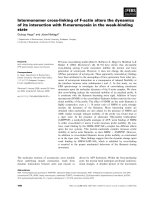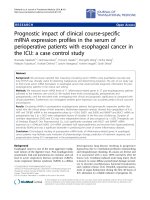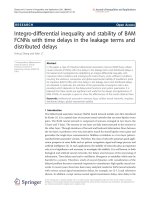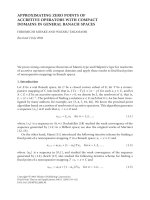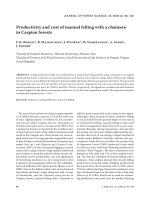Relationship of demographic profile of dairy farmers with transitional diseases in Punjab, India
Bạn đang xem bản rút gọn của tài liệu. Xem và tải ngay bản đầy đủ của tài liệu tại đây (308.67 KB, 6 trang )
Int.J.Curr.Microbiol.App.Sci (2018) 7(8): 3032-3037
International Journal of Current Microbiology and Applied Sciences
ISSN: 2319-7706 Volume 7 Number 08 (2018)
Journal homepage:
Original Research Article
/>
Relationship of Demographic Profile of Dairy Farmers with Transitional
Diseases in Punjab, India
Niharika Thakur, Parminder Singh*, Bharti Deshmukh and Rajesh Kasrija
Department of Veterinary and Animal Husbandry Extension Education, Guru Angad Dev
Veterinary and Animal Sciences University (GADVASU), Ludhiana, Punjab, India
*Corresponding author
ABSTRACT
Keywords
Dairy, Education,
Punjab, Training,
Transitional period
Article Info
Accepted:
17 July 2018
Available Online:
10 August 2018
The present study was conducted in different districts of Punjab. 250 respondents were
randomly selected and were interviewed personally the help of pretested interview
schedule. Most of the farmers were middle aged and young. The education level of most of
the farmers was more than high school. Most of the dairy farmers (52%) were medium
dairy farmers followed by small dairy farmers (28%), large dairy farmers (12%) and very
large dairy farmers (8%). Herd Size had a significant difference (P<0.05) on incidence of
diseases like mastitis, ketosis and milk fever. It was found that medium farms (10-29) were
significantly (P<0.05) affected by incidence of diseases like mastitis, ketosis and milk
fever. Incidence of metritis (30.36%) was found to be less for farmers who undertook
training, indicating the significant relationship (P<0.05) between training and metritis
occurrence. Education vary significantly with control of mastitis and metritis (P<0.05),
indicating its role in control of mastitis and metritis. So, this study focuses on role of
training and education in enhancing awareness level of dairy farmers about control of
various transitional diseases.
Introduction
Punjab is one of the leading states in dairying
and milk production, producing 11.28 Million
tonnes of milk, of the total milk production of
country which is 165.4 Million Tonnes
(National Dairy Development report, 201617). The enhancement in milk production of
dairy animals is directly related with good
reproductive efficiency (Emanuelson and
Oltenacut 1998) and the success of dairy
farming lies in ensuring proper and optimal
reproductive rhythm of an individual animal in
the herd (Agarwal et al., 2005). Economic
viability of a dairy venture depends upon
reproductive efficiency of its herd. The
transition period of a dairy animal (last three
weeks before parturition to three weeks after
parturition) is of utmost importance as there
are tremendous metabolic and endocrine
adjustments that the cows must experience
from late gestation to early lactation
(Grummer, 1995). During transition period,
the animal is prone to various diseases such as
Milk fever, Ketosis, Retained placenta,
Anestrous, Dystokia, Metritis, Mastitisetc.
One transition disease may trigger another
transitional disease in animals. The
3032
Int.J.Curr.Microbiol.App.Sci (2018) 7(8): 3032-3037
reproductive disorders such as anoestrus,
metritis leads to lesser calves, decreased milk
production, long service period and increase in
intercalving
interval,
thereby
causing
economic losses, leading to infertility and
increasing culling rate of animals. So, present
study was planned to know about incidence of
transitional diseases and relationship of
demographic profile with transitional diseases
in Punjab.
Since per unit income is not increasing only
alternative is bigger the farm size, more is the
income. It means livestock is still in phase of
development. 58% respondents did not
undertake any training. Similarly, Laldinpuii
(2013) also reported that majority (67.6%)
farmers did not attend any training on dairy
farming. It may be due to the reason that
farmers are not having any awareness
regarding curriculum of training programmes.
Materials and Methods
Incidence of transitional diseases
The present study was conducted on 250
randomly selected dairy farmers from
different districts of Punjab. Dairy farmers
were personally interviewed with the help of
pretested
interview
schedule.
The
demographic profile parameters of dairy
farmers such as age, education, herd size and
any training were also noted. The data was
tabulated and put to suitable statistical analysis
with the help of SAS 9.3 system Carry N C,
USA.
Figure 1 clearly indicate that highest incidence
was found to be of anoestrus (59.6%) followed
by mastitis (52%), retention of placenta
(38%), metritis (22.4%), milk fever (18%),
dystokia (14.8%) and ketosis (10.4%). Kasrija
(2016) reported similar incidence of anoestrus
in dairy farms of sub mountain undulating
region of Punjab. The farmers did not provide
proper nutrition during the dry period and
even duration of dry period was short. This
resulted in negative energy in animals and
animals failed to ovulate. Mir et al., 2015
reported that incidence of mastitis was high
due to lack of managemental practices viz
hygiene practices related to milking.
Results and Discussion
It is clear from Table 1 that most (40%) of the
dairy farmers belonged to middle age group
(34-46 years), followed by 30.8% to young
age group (<34 years) and 29.2% to old age
group. Rajput et al., (2012) also reported that
majority of dairy farmers belonged to middle
age group followed by young and old age
groups. The education level of most of the
farmers is more than high school. Parmar
(2014) also reported that farmers are
becoming educated with changing times and
are trying to enhance their knowledge level.
Most of the dairy farmers (52%) were medium
dairy farmers followed by small dairy farmers
(28%), large dairy farmers (12%) and very
large dairy farmers (8%). However, Kaur
(2006) found 45.5% farmers had small herd
strength (4-10). It means with passage of time
the herd size of farmers’ is also growing.
Table 2 indicates that age and education of
dairy farmer had no significance effect on
occurrence of transitional diseases. Herd Size
had a significant difference (P<0.05) with
incidence of diseases like mastitis, ketosis and
milk fever. It was found that medium farms
(10-29) were significantly (P<0.05) affected
by incidence of diseases like mastitis, ketosis
and milk fever. Incidence of diseases like
mastitis, ketosis and milk fever were more
common in medium farms because of lack of
management and hygiene practices leading to
mastitis, and occurrence of milk fever and
ketosis are due to lack of proper nutritive
modifications and improper Dietary cationicanionic difference (DCAD) during transition
period.
3033
Int.J.Curr.Microbiol.App.Sci (2018) 7(8): 3032-3037
Fig.1 Percentage of incidence of transitional diseases
48
40.4
62
82
85.2
52
77.6
89.6
59.6
38
18
14.8
Dystokia
ROP
Mastitis Anoestrus
Milk
Fever
Yes
No
22.4
10.4
Ketosis
Metritis
Table.1 Distribution of dairy farmers with respect to demographic profile
Parameters (n=250)
Age(in years)
Education
Herd Size
Training
Category
Frequency
Percentage
Young (<34)
Middle (34 - 46)
Aged (>46)
Illiterate
Primary
Middle
High School
Higher Secondary
Graduate and above
Small (<10)
Medium (10-29)
Large (30-49)
Very large (≥50)
Yes
No
77
100
73
12
13
10
76
59
80
70
130
30
20
105
145
30.80
40.00
29.20
4.80
5.20
4.00
30.40
23.60
32.00
28.00
52.00
12.00
8.00
42.00
58.00
3034
Int.J.Curr.Microbiol.App.Sci (2018) 7(8): 3032-3037
Table.2 Relationship of demographic profile with incidence of various transitional diseases
Parameter
(n=250)
Age
(Years)
Category
Dystokia
ROP
Young
11(29.73)
28(29.47)
(<34)
Middle (34
17(45.95)
37(38.95)
46)
Old (>46)
9(24.32)
30(31.58)
Overall
37(14.80)
95(38.00)
Illiterate
1(2.70)
6(6.32)
Education
Primary
2(5.41)
6(6.32)
Middle
0(0.00)
3(3.16)
High School 12(32.43)
23(24.21)
Higher
9(24.32)
20(21.05)
Secondary
Graduate
13(35.14)
37(38.95)
and above
Overall
37(14.80)
95(38.00)
Small (<10) 9(24.32)
32(33.68)
Herd Size
Medium
18(48.65)
40(42.11)
(10-29)
Large (305(13.51)
14(14.74)
49)
Very large
5(13.51)
9(9.47)
(≥50)
Overall
37(14.80)
95(38.00)
Yes
14(37.84)
35(36.84)
Training
No
23(62.16)
60(63.16)
Overall
37(14.80)
95(38.00)
Figure in parenthesis indicates percentage
(*)= Significant at 5% (P <0.05)
Mastitis
Anoestrus
Milk Fever
Ketosis
Metritis
34(26.15)
43(28.86)
13(28.89)
2(26.92)
14(25.00)
58(44.62)
56(37.58)
21(46.67)
12(46.15)
24(42.86)
38(29.23)
130(52.00)
6(4.62)
6(4.62)
5(3.85)
35(26.92)
29(22.31)
50(33.56)
149(59.60)
5(3.36)
9(6.04)
6(4.03)
53(35.57)
31(20.81)
11(24.44)
45(18.00)
1(2.22)
2(4.44)
2(4.44)
16(35.56)
11(24.44)
7(26.92)
26(10.40)
0(0.00)
2(7.69)
0(0.00)
10(38.46)
5(19.23)
18(32.14)
56(22.40)
2(3.57)
4(7.14)
1(1.79)
22(39.29)
14(25.00)
49(37.69)
45(30.20)
13(28.89)
9(34.62)
13(23.21)
130(52.00)
28(21.54)
72(55.38)*
149(59.60)
49(32.89)
72(48.32)
45(18.00)
9(20.00)
19(42.22)*
26(10.40)
11(42.31)
9(34.62)*
56(22.40)
3(37.50)
5(62.50)
14(10.77)
19(12.75)
19(42.22)
6(23.08)
0(0.00)
16(12.31)
9(6.04)
6(13.33)
0(0.00)
0(0.00)
130(52.00)*
54(41.54)
76(58.46)
130(52.00)
149(59.60)
60(40.27)
89(59.73)
149(59.60)
45(18.00)*
18(40.00)
27(60.00)
45(18.00)
26(10.40)*
17(65.38)
9(34.62)
26(10.40)
8(3.20)
17(30.36)*
39(69.64)
56(22.40)*
Table.3 Effect of education to control incidence of transitional diseases
Education
Transitional
diseases
(n=250)
Mastitis
Metritis
Category
Illiterate
Primary
Middle
Secondary
Higher
Secondary
Graduate
and above
Overall
(n=250)
Nil
Any medicine
Veterinarian
Teat Dips
Nil
Antibiotic
I/U
Veterinarian
6(4.92)
4(3.70)
1(5.26)
0(0.00)
10(5.18)
0(0.00)
2(4.35)
0(0.00)
7(5.74)
5(4.63)
1(5.26)
0(0.00)
9(4.66)
0(0.00)
1(2.17)
3(37.50)
5(4.10)
4(3.70)
1(5.26)
0(0.00)
9(4.66)
0(0.00)
1(2.17)
0(0.00)
42(34.43)
31(28.70)
3(15.79)
0(0.00)
54(27.98)
0(0.00)
19(41.30)
3(37.50)
30(24.59)
24(22.22)
52(26.32)
0(0.00)
44(22.80)
1(33.33)
14(30.43)
0(0.00)
32(26.23)
40(37.04)
8(42.11)
1(1.00)
67(34.72)
2(66.67)
9(19.57)
2(25.00)
122(48.80)
108(43.20)
19(7.60)
1(0.40)
193(77.20)
3(1.20)
46(18.40)
8(3.20)
Figure in parenthesis indicates percentage
(*)= Significant at 5% (P<0.05)
3035
ᵪ2
Value
25.36*
28.86*
Int.J.Curr.Microbiol.App.Sci (2018) 7(8): 3032-3037
Table.4 Effect of herd size to control incidence of transitional diseases
Transitional
diseases (n=250)
Mastitis
Milk Fever
Metritis
Category
<10
(Small)
Nil
43(17.20)
Any Medicine
58(23.20)*
Veterinarian
21(6.80)*
Teat dips
0(0.00)
Nil
61(87.14)
Oral Calcium
111(85.38)*
Mifex, Mineral Mixture 19(63.33)*
Veterinarian
14(70.00)*
Nil
48(68.57)
Antibiotic
106(81.54)*
I/U
26(86.67)*
Veterinarian
13(65.00)*
10-29
(Medium)
26(10.40)
57(22.80)*
25(9.40)
0(0.00)
7(10.00)
14(10.77)
8(26.67)
3(15.00)
0(0.00)
1(0.77)
1(3.33)
1(5.00)
30-49
(Large)
1(1.43)
14(5.60)
4(1.36)
0(0.00)
2(2.86)
5(3.85)
2(6.67)
2(10.00)
19(27.14)
18(13.85)
3(10.00)
6(30.00)
≥50
(Very large)
0(0.00)
1(0.40)
0(0.00)
0(0.00)
0(0.00)
0(0.00)
1(3.33)
1(5.00)
3(4.29)
5(3.85)
0(0.00)
0(0.00)
ᵪ2
Value
17.09*
18.13*
15.32*
Figures in parenthesis indicates percentage
(*)= Significant at 5% (P< 0.05)
Berge et al., (2014) also revealed that large herd
size was associated with lower incidence of
ketosis and milk fever as those farms were
feeding total mixed ration.
Training was found to be significantly (P<0.05)
associated with occurrence of metritis.
Incidence of metritis (30.36%) was found to be
less for farmers who undertook training. Other
transitional diseases were found to be nonsignificant but still the impact of training is that
there were less incidence of transitional diseases
in the farms. It means that by undertaking
training farmers became well versed about the
incidence of transitional diseases and took
various preventive measures to control the
incidence of these diseases. Similarly, Smith
and Risco (2005) also revealed that proper
training to farmers may help them to identify
the sick animal in early stages of disease,
thereby allowing routine, reliable treatment
methods and swift return of the animal to
healthy state.
Effect of education to control incidence of
transitional diseases was also studied. Except
for mastitis and metritis, control of all other
transitional diseases were reported to be non-
significantly associated with education. Table
3depicts that education vary significantly with
control of mastitis and metritis (P<0.05).It
means education has a role in control of these
mentioned diseases. For control of mastitis it
was found that 37.04 % farmers who were
graduate and above tried their self-medication
and 26% farmers belonging to secondary
education consulted vets. Teat dips were not
used much except for 1% by dairy farmers who
were graduates and above. It means that with
increase in education the knowledge and
awareness of dairy farmers increased, which
helped them to take various remedial measures
in cases of emergency if necessary. Similarly,
Mulligan and Doherty (2008) revealed that
significant body of knowledge should exist
which allows for optimal management and
prevention of various production diseases.
Table 4 shows that effect of herd size to control
incidence of transitional diseases was
significantly (P<0.05) associated for control of
diseases like mastitis, milk fever, metritis. For
control of mastitis small farmers (23.2%) were
giving self-medication according to their
knowledge, while for controlling milk fever
85.38%, 63.33%, small farmers were giving
3036
Int.J.Curr.Microbiol.App.Sci (2018) 7(8): 3032-3037
oral calcium, mifex and mineral mixture
respectively. 70% small farmers were also
consulting Veterinarian for controlling the
incidence of transitional diseases. For
controlling metritis too small farmers were
making more efforts to control its incidence.
81.54% farmers were giving antibiotic to
animals, while, 86.67% had knowledge about
administering of intrauterine treatment. 65%
small farmers were consulting vets to control
the incidence. Hence, it can be analysed that
small farmers were more vigilant to take care of
their animals as their herd size is small, which is
easily manageable. Another reason may be that
small farmers took training from any
organisation or they may be more educated.
The present study highlights the incidence of
various transitional diseases at dairy farms.
Highest incidence was found to be of anoestrus
(59.6%) followed by mastitis (52%), retention
of placenta (38%), metritis (22.4%), milk fever
(18%), dystokia (14.8%) and ketosis (10.4%).
The herd size and training to dairy farmer was
reported to be significantly (P <0.05) associated
with incidence of transitional diseases. The
effect of herd size to control incidence of
transitional diseases was significantly (P<0.05)
associated for control of diseases like mastitis,
milk fever, metritis. The effect of education had
significant impact to control diseases like
mastitis and metritis. So, more training
programmes and knowledge enrichment drives
should be organized for enhancing the
awareness level of dairy farmers about various
transitional diseases.
References
Agarwal, S. K., Singh, S. K. and Rajkumar, R.
2005. Reproductive disorders and their
management in cattle and buffalo: A
review. Indian Journal of Animal Science
75 (7): 858-73.
How to cite this article:
Berge, A. C. and Vertenten, G. 2014. A field
study to determine the prevalence, dairy
herd management systems, and fresh cow
clinical conditions associated with ketosis
in western European dairy herds. Journal of
Dairy Science 97(4): 2145-54.
Emanuelson, U. and Oltenacut, P. A. 1998.
Incidence and effects of diseases on
performance of Swedish dairy herds
stratified by production. Journal of Dairy
Science 81: 2376-82.
Grummer, R. R. 1995. Impact of changes in
organic nutrient metabolism on feeding the
transition dairy cow. Journal of Animal
Sciences 73: 2820-33.
Kasrija, R. 2016. ‘Effectiveness of instructional
material designed on the basis of felt needs
of the dairy farmers of Punjab regarding
common reproductive conditions’. Ph.D.
Dissertation, Guru Angad Dev Veterinary
and Animal Sciences University, Ludhiana,
India.
Laldinpuii, N. 2013. Studies on dairy farming
practices followed and training needs of
dairy farmers in Punjab. M.V.Sc. Thesis,
Guru Angad Dev Veterinary and Animal
Sciences University, Ludhiana, India.
Mir, A. Q., Bansal, B. K., Gupta, D. K.
2015.Short term changes in teats following
machine with respect to quarter health
status in cows. Journal of Animal Research
5(3): 467-71.
Mulligan, F. J. and Doherty, M. L. 2008.
Production diseases of the transition cow.
The Veterinary Journal 176(1): 3-9.
Parmar, S. S. 2014. Prevalence of common
reproductive problems in dairy animals
with respect to management practices in
different agroclimatic zones of Punjab.
M.V.Sc. Thesis, Guru Angad Dev
Veterinary and Animal Sciences University,
Ludhiana, India.
Smith, B. I. and Risco, C. A. 2005. Management
of periparturient disorders in dairy cattle.
Veterinary Clinics: Food Animal Practice
21: 503-21.
Niharika Thakur, Parminder Singh, Bharti Deshmukh and Rajesh Kasrija. 2018. Relationship of
Demographic Profile of Dairy Farmers with Transitional Diseases in Punjab, India.
Int.J.Curr.Microbiol.App.Sci. 7(08): 3032-3037. doi: />
3037


